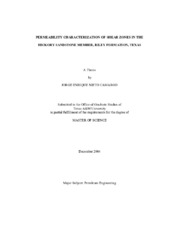| dc.contributor.advisor | Chester, Frederick | |
| dc.contributor.advisor | Jensen, Jerry L. | |
| dc.creator | Nieto Camargo, Jorge Enrique | |
| dc.date.accessioned | 2005-02-17T21:00:13Z | |
| dc.date.available | 2005-02-17T21:00:13Z | |
| dc.date.created | 2004-12 | |
| dc.date.issued | 2005-02-17 | |
| dc.identifier.uri | https://hdl.handle.net/1969.1/1391 | |
| dc.description.abstract | Reservoir compartments, typical targets for new infill locations, are commonly created by faults that may reduce or enhanced permeabilities. Faults often contain narrow zones of intense shear comprised of geometrically complex elements that reduce permeability and compartmentalize blocks as a function of time and pressure. This thesis characterizes the permeability structure of shear zones and the relationship between fault permeability, host rock properties and the relative degree of deformation.
The main objectives of this work are to (1) characterize the geometry and permeability of deformation elements within shear zones; (2) determine permeability anisotropy in shear zones according to fault characteristics and host lithology; and (3) develop a process to predict permeability anisotropy of faults in reservoirs using probabilistic approaches.
The study results give a better understanding of fluid flow behavior of shear zones and their potential to create reservoir heterogeneity and compartmentalization. Fluid flow in a reservoir with faults is controlled by variables such as fault throw, shear-zone thickness, undeformed and deformed rock permeability and the geometry of all deformation elements.
Methodology to predict permeability structure was developed using analytical and numerical simulation of selected core samples and laboratory measurements. We found useful relationships between permeability of the host rock and highly deformed elements according to the amount of throw of the fault. The high lateral continuity of the highly deformed elements and their predictable low permeability make these elements most important in controlling permeability in shale-free and low-shale shear zones created by low displacement (subseismic) faulting.
Probe permeameter data is a precise, inexpensive and non-destructive source of permeability information that can be effectively incorporated in detailed models to investigate the effect of individual deformation elements in the whole shear zone permeability and their effect at the field scale. | en |
| dc.format.extent | 15617941 bytes | en |
| dc.format.medium | electronic | en |
| dc.format.mimetype | application/pdf | |
| dc.language.iso | en_US | |
| dc.publisher | Texas A&M University | |
| dc.subject | Permeability | en |
| dc.subject | Shear | en |
| dc.subject | Hickory | en |
| dc.subject | Faults | en |
| dc.title | Permeability characterization of shear zones in the Hickory sandstone member, Riley Formation, Texas | en |
| dc.type | Book | en |
| dc.type | Thesis | en |
| thesis.degree.department | Petroleum Engineering | en |
| thesis.degree.discipline | Petroleum Engineering | en |
| thesis.degree.grantor | Texas A&M University | en |
| thesis.degree.name | Master of Science | en |
| thesis.degree.level | Masters | en |
| dc.contributor.committeeMember | Maggard, Bryan | |
| dc.type.genre | Electronic Thesis | en |
| dc.type.material | text | en |
| dc.format.digitalOrigin | born digital | en |


